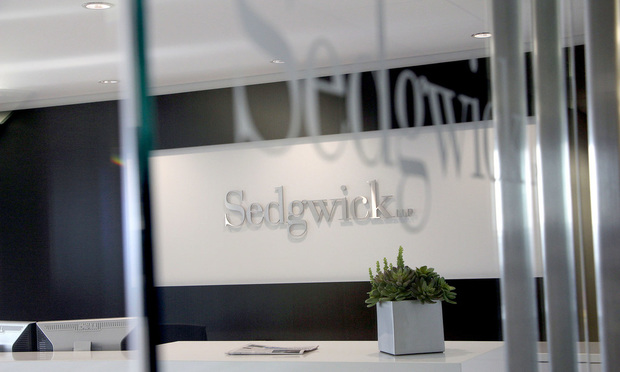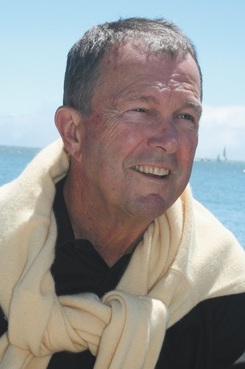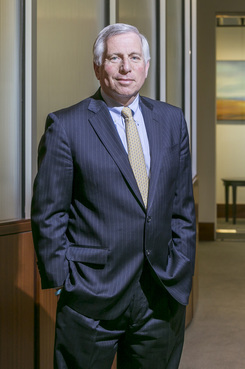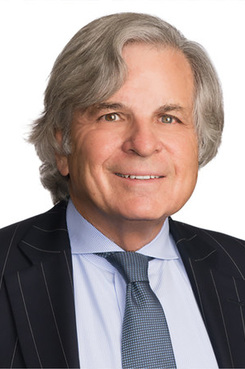Once Storied Sedgwick Files for Bankruptcy as Wind-Down Fails
The firm's insolvency comes after a broad expansion effort, practice groups that sparred with each other and an ultimately unsuccessful attempt to stabilize an institution rocked by the financial uncertainty that comes with Big Law's free agent era.
October 02, 2018 at 04:38 PM
13 minute read

The defunct law firm Sedgwick filed for Chapter 11 protection Tuesday in San Francisco after an attempted out-of-court wind-down failed.
Sedgwick, founded in San Francisco in 1933, closed its doors earlier this year following a raft of partner departures. The story of the firm's demise is one based on a broad expansion effort, practice groups that sparred with each other and an ultimately unsuccessful attempt to stabilize an institution rocked by the financial uncertainty that comes with Big Law's free agent era.
Since January, a group of three former Sedgwick partners and financial advisory firm Development Specialists Inc. have been attempting to settle creditors' claims by looking into clawback payments from former partners.
The former Sedgwick partners on its dissolution committee are Bruce Celebrezze, Curtis Parvin and Gregory Read. Celebrezze and Parvin now work at Clyde & Co, a British firm that absorbed a large group of former Sedgwick lawyers and staffers, while Read is now special counsel with San Francisco-based Gough & Hancock. (Shortly before Sedgwick dissolved, The Recorder sat down with Read to discuss his Christmas train set collection.)
The bankruptcy filing Tuesday by Sedgwick in the Northern District of California states that talks with a group of 12 of the busted firm's largest creditors ultimately hit a roadblock.
“While Sedgwick believed the meetings were productive, the ad hoc group of creditors was not willing to continue negotiations outside the context of a formal bankruptcy filing,” states a court filing from Sedgwick, which is being advised by national bankruptcy boutique Pachulski Stang Ziehl & Jones.
Sedgwick's bankruptcy filing states that it has liabilities of between $10 million and $50 million, much of which consists of unpaid lease obligations. About $9 million of the defunct firm's liabilities are owed through accounts payable. This year Sedgwick has been sued by multiple landlords claiming that the firm failed to pay lease termination fees.
The firm's assets, according to its bankruptcy filing, are about $1.56 million in cash, accounts receivable with a face value of more than $5 million, estimated accounts receivable worth about $1.5 million and distributions from the firm's former U.K. partnership of $725,000.
John Lucas, a Pachulski Stang partner in San Francisco representing Sedgwick in its bankruptcy, said the firm has potential claims against former partners that could lead to clawbacks of their compensation.
“We're going to analyze whether there are claims, and we're going to do it hand-in-hand with the committee and partners so it can be done in the context of an agreement and not in litigation,” Lucas said. “That's the whole purpose and goal of everybody involved.”
Sedgwick's bankruptcy filing states that it continued to pay its employees' salaries through the end of 2017 and that it had no debt or line of credit from Citigroup Inc. at the time it officially ceased providing client services in January.
The Road to 400
Sedgwick, long known as having one of the strongest insurance defense practices in the country, was once an ambitious firm.
Kevin Dunne, who joined the firm when it had only 22 lawyers, created a plan he called the “Road to 400” during his tenure as managing partner from 2001 to 2007. It was a plan to grow Sedgwick from about 300 lawyers to 400.
 Kevin Dunne
Kevin Dunne“I couldn't afford consultants, so I had to do this all on my own. And I was asking myself how do we tell the firm we're going to go to 400 when we had only about 300?” Dunne said Tuesday. “I arbitrarily just assigned each office would get 10 this year, another would get 10 the next year. And every time I would get up in front of the firm I would report on how we're doing on the road to 400.”
Under Dunne's tenure, Sedgwick grew gross revenue from $104.5 million in 2000 to $172 million in 2006. The Recorder reported in 2007 that Sedgwick had 401 lawyers in an article touting Dunne's successor as chairman: Michael Tanenbaum. The American Lawyer reported that Sedgwick's high water mark in terms of head count was 380 lawyers in 2008. Within a decade, they would all be gone.
Tanenbaum had been a lateral hire in 2001, and his New Jersey practice was brought into Sedgwick on account of a shared client with Dunne: New York-based pharmaceutical giant Bristol-Myers Squibb. While Tanenbaum was the first partner to lead Sedgwick from outside of San Francisco, he continued the tradition of a rainmaker leading the way.
Tensions Between Practices
Tanenbaum's practice was the largest in a firm known for handling mass tort litigation and product liability cases, said a former Sedgwick partner.
The growth of the mass tort practice created some division within Sedgwick, said three former partners, all of whom claimed that Tanenbaum's rates didn't match up with the increasingly commoditized work in insurance defense.
“At many firms that have a commercial practice and an insurance coverage practice, something has to give because sometimes the practices don't mesh,” said a former Sedgwick partner. “People get different rates and other practices get different volume, but lawyers [in the insurance practice], they're working harder than the other group.”
Two former Sedgwick partners said the firm had discussed splitting the practice groups into different firms. One former partner said that at a partner retreat in 2012, Tanenbaum floated the idea of a split in front of the partnership.
“It sent shudders down the insurance practice,” said one ex-Sedgwick partner. “There was resentment on the part of the mass tort lawyers at the insurance practice.”
Tanenbaum, now head of Newark, New Jersey-based litigation boutique Tanenbaum Keale, declined to comment when asked about that tension.
Departures Begin
Sedgwick had seen its finances start to slide in 2013 following what would be its best year, 2012, when the firm brought in $212 million in gross revenue. By 2016, gross revenue had dipped to $183 million, according to The American Lawyer's reporting.
In the beginning of 2017, Sedgwick was planning for the new year just “like any other,” according to Tuesday's bankruptcy filing, even if the firm's head count had by then dipped to 218 lawyers and 350 staff members. (In early 2012, Sedgwick had some 340 lawyers.)
“At the outset of 2017, it was business as usual,” states Sedgwick's bankruptcy filing.
But that quickly changed when two large groups totaling 83 lawyers and staff announced they would be departing.
 Michael Tanenbaum
Michael TanenbaumThe first group to leave, announced internally on Jan. 5, 2017, was Tanenbaum's New Jersey-based practice, which accounted for 45 lawyers and staff. Two days later, Sedgwick's Dallas office, including 23 partners, told firm leadership that they were headed to Drinker Biddle & Reath. That group was led by partner Wayne Mason, who had a well-known class action and complex litigation practice.
“This was really an opportunity for us to continue to build our practices on a larger platform,” Mason said at the time. “The change makes sense at every level for us.”
The Firm Reacts
Sedgwick was caught off guard, stating in its bankruptcy filing Tuesday that the early 2017 exodus was not expected.
But the firm's leadership reacted quickly to the moves by assigning its Dallas office lease to Drinker Biddle and subletting most of its space in Newark to Tanenbaum Keale. The latter has expanded quickly since leaving Sedgwick, having late last year absorbed the now-defunct firm's complex liability practice in Seattle.
Sedgwick also reduced the draws it allowed to equity partners. Compensation was adjusted based on the effects of the departing partners and on projections by the firm's CFO, the debtor said in its Chapter 11 petition. Sedgwick's partners committed to those reduced payments rather than seeking to take out loans to true-up their compensation during a partners' meeting in February 2017.
“Sedgwick was compensating its equity partners in accordance with its projections, and in most cases in amounts substantially less than the partners were entitled given the amount of time and effort they spent for the remainder of the year continuing to bill, originate business and helping provide the firm with a bridge to a merger, acquisition or re-sized firm,” said Sedgwick in bankruptcy papers.
Sedgwick's leadership “believed the firm was stable” by March 2017. But in April, Citibank, which provided the firm with a $17 million line of credit, sent Sedgwick a reservation of rights regarding the number of equity partners that were required at the firm to keep the credit line open. With 85 percent of the partnership still intact and committed to staying, Sedgwick and Citi did not revise down the requirement, states the firm's bankruptcy filing.
The firm appeared to have taken on a strategy of consolidation that led to its office in Washington, D.C., an outpost opened after absorbing the bulk of a smaller firm in 2011, being closed after the last of its two partners joined Troutman Sanders in August 2017. Sedgwick sublet most of its office space in the nation's capital and said it was relieved not to have to pay its lawyers there anymore, according to its bankruptcy filing.
“The equity partners who most recently left were on the lower end of the spectrum of revenue generation,” said Sedgwick about the departure of those in Washington, D.C.
The Bank Calls
In August 2017, after a spate of departures left Sedgwick below the required number of equity partners, Citi withdrew its line of credit, which had about $3 million in outstanding payments. Sedgwick said it was able to repay that debt by last November.
At that point, 31 equity partners were committed to staying at Sedgwick, either as a much smaller regional firm or after it had merged with another firm. Sedgwick sought whole mergers, as well as mergers of its insurance practice and litigation practice separately. Ultimately, Sedgwick pursued discussions with six different firms. Partners were getting paid less than 50 percent of what they expected, Sedgwick said in court filings.
By the end of November, Sedgwick believed it could turn a small profit for the year. But the uncertainty of what such a drastically smaller firm would look like—or what type of talent it could recruit—led the firm to question its ongoing viability.
“In short, the equity partners recognized that despite their best efforts to keep the firm going, continuing operations was no longer a viable or realistic alternative on a long term basis. Accordingly, the equity partners voted in December 2017 to wind up the firm,” Sedgwick said.
Most of the partners remaining at Sedgwick prepared to join the U.K.'s Clyde & Co, which ultimately picked up about 15 partners amid an 80-strong group of lawyers and staff.
The Fight Ahead
Without a workout being reached outside of court, creditors will now be in a battle with Sedgwick's former partners.
 Leslie Corwin
Leslie Corwin“Eventually there will be a plan of dissolution, and the cornerstone of the plan will be contributions from partners to supplement any other assets, most notably accounts receivable and work in progress,” said Leslie Corwin, a veteran Big Law partnership expert who this past summer joined Beverly Hills-based boutique Eisner.
Corwin, who has handled the bankruptcies of former legal luminaries Heller Ehrman and Testa, Hurwitz & Thibeault, has also represented now-defunct Wolf Block in its yearslong, out-of-court liquidation process.
Often, the determination of what former partners will pay is made by a finding of when the firm was insolvent. That can be a drag-out fight among former partners who want to argue that they left while the firm was financially stable, Corwin said. Sedgwick's bankruptcy filing does not make any direct claims as to when the firm was insolvent, noting that leaders believed they could turn a profit even in 2018.
“When I represent law firms, accounting firms and investment firms, I try like hell to stay out of bankruptcy,” Corwin said. “If you're a former partner at a law firm, it's your worst nightmare.”
In the end, Sedgwick's Chapter 11 filing states that all the lawyers and staff who wanted to continue working in the legal market were able to find jobs. Still, the dissolution of a firm that lived as long as Sedgwick—it lasted 85 years—can leave an emotional scar.
“I'm just trying to put that whole experience out of my mind,” said one ex-Sedgwick partner.
As for Dunne, the retired chairman-turned-author, he said he was “devastated” watching the firm on its road to bankruptcy.
“I was just torn apart. It was the only law firm I know. The only law firm I practiced at. It was hard,” Dunne said. “But in terms of my life, it didn't change anything. So I've come to rationalize this whole thing by saying, 'Hey, it did good while I was there. What can I say?'”
Dunne likely isn't the last law firm leader to think as much.
In late August another California-based firm, Archer Norris, filed for bankruptcy in San Francisco. Archer Norris stopped providing client services in mid-September as a number of its lawyers left for other firms, including its former leader, who joined Buchalter.
Read Sedgwick's Chapter 11 filing:
Related Stories:
At Sedgwick, What's Done Is Dunne
Sedgwick to Shutter Operations in January
Sedgwick Departures Continue As Chicago Managing Partner Leaves For UK Rival
Big British Firm Bolts on Struggling Sedgwick's Bermuda Base
This content has been archived. It is available through our partners, LexisNexis® and Bloomberg Law.
To view this content, please continue to their sites.
Not a Lexis Subscriber?
Subscribe Now
Not a Bloomberg Law Subscriber?
Subscribe Now
NOT FOR REPRINT
© 2025 ALM Global, LLC, All Rights Reserved. Request academic re-use from www.copyright.com. All other uses, submit a request to [email protected]. For more information visit Asset & Logo Licensing.
You Might Like
View All
Law Firms Expand Scope of Immigration Expertise Amid Blitz of Trump Orders
6 minute read

Am Law 100 Lateral Partner Hiring Rose in 2024: Report

JCPenney Seeks Return of More Than $1.1M From Jackson Walker For Bankruptcy Work
3 minute readTrending Stories
- 1'Careless Execution' of Presidential Pardons Freed Convicted Sex Trafficker, US Judge Laments
- 2Newsmakers: Littler Elevates Dallas Attorney to Shareholder
- 3South Florida Real Estate Lawyers See More Deals Flow, But Concerns Linger
- 4General Counsel Accused of Destroying Evidence
- 52,000 Docket Entries: Complex South Florida Dispute Sets Precedent
Who Got The Work
J. Brugh Lower of Gibbons has entered an appearance for industrial equipment supplier Devco Corporation in a pending trademark infringement lawsuit. The suit, accusing the defendant of selling knock-off Graco products, was filed Dec. 18 in New Jersey District Court by Rivkin Radler on behalf of Graco Inc. and Graco Minnesota. The case, assigned to U.S. District Judge Zahid N. Quraishi, is 3:24-cv-11294, Graco Inc. et al v. Devco Corporation.
Who Got The Work
Rebecca Maller-Stein and Kent A. Yalowitz of Arnold & Porter Kaye Scholer have entered their appearances for Hanaco Venture Capital and its executives, Lior Prosor and David Frankel, in a pending securities lawsuit. The action, filed on Dec. 24 in New York Southern District Court by Zell, Aron & Co. on behalf of Goldeneye Advisors, accuses the defendants of negligently and fraudulently managing the plaintiff's $1 million investment. The case, assigned to U.S. District Judge Vernon S. Broderick, is 1:24-cv-09918, Goldeneye Advisors, LLC v. Hanaco Venture Capital, Ltd. et al.
Who Got The Work
Attorneys from A&O Shearman has stepped in as defense counsel for Toronto-Dominion Bank and other defendants in a pending securities class action. The suit, filed Dec. 11 in New York Southern District Court by Bleichmar Fonti & Auld, accuses the defendants of concealing the bank's 'pervasive' deficiencies in regards to its compliance with the Bank Secrecy Act and the quality of its anti-money laundering controls. The case, assigned to U.S. District Judge Arun Subramanian, is 1:24-cv-09445, Gonzalez v. The Toronto-Dominion Bank et al.
Who Got The Work
Crown Castle International, a Pennsylvania company providing shared communications infrastructure, has turned to Luke D. Wolf of Gordon Rees Scully Mansukhani to fend off a pending breach-of-contract lawsuit. The court action, filed Nov. 25 in Michigan Eastern District Court by Hooper Hathaway PC on behalf of The Town Residences LLC, accuses Crown Castle of failing to transfer approximately $30,000 in utility payments from T-Mobile in breach of a roof-top lease and assignment agreement. The case, assigned to U.S. District Judge Susan K. Declercq, is 2:24-cv-13131, The Town Residences LLC v. T-Mobile US, Inc. et al.
Who Got The Work
Wilfred P. Coronato and Daniel M. Schwartz of McCarter & English have stepped in as defense counsel to Electrolux Home Products Inc. in a pending product liability lawsuit. The court action, filed Nov. 26 in New York Eastern District Court by Poulos Lopiccolo PC and Nagel Rice LLP on behalf of David Stern, alleges that the defendant's refrigerators’ drawers and shelving repeatedly break and fall apart within months after purchase. The case, assigned to U.S. District Judge Joan M. Azrack, is 2:24-cv-08204, Stern v. Electrolux Home Products, Inc.
Featured Firms
Law Offices of Gary Martin Hays & Associates, P.C.
(470) 294-1674
Law Offices of Mark E. Salomone
(857) 444-6468
Smith & Hassler
(713) 739-1250










